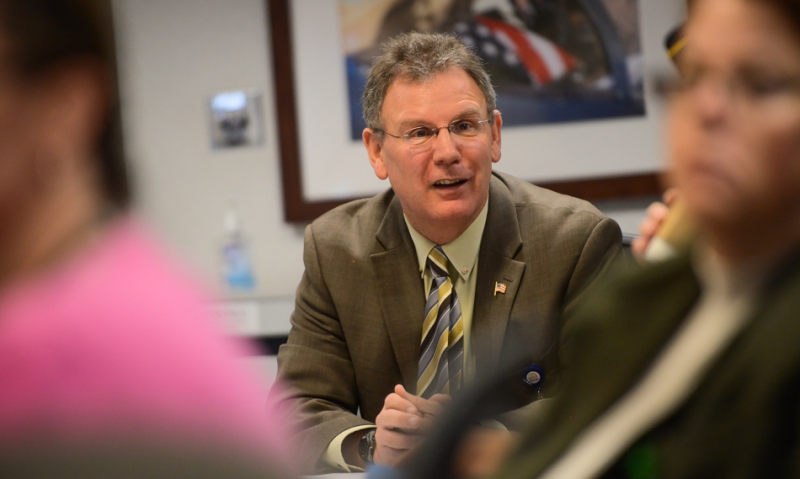
SWS site visit to Michigan VA positive
 View Photo Gallery
View Photo Gallery
The VA Ann Arbor (Mich.) Health care System was the first health care organization in the U.S. to receive silver status from Planetree for significant advancement in patient-centered care. The honorable recognition is one of several ways the facility has made great strides in becoming a veterans-centered organization since 2003 — the last time The American Legion’s System Worth Savings (SWS) Task Force conducted a site visit.
“Our goal is to truly become a veteran-driven organization with veterans actively involved in every facet of our organization from our governance board to health-care delivery and everything in between,” said Robert McDivitt, director of Ann Arbor VA and a member of American Legion Post 46. “Our mission is to honor America’s veterans by providing exceptional health care that improves their health and well-being.”
Members of the Legion’s SWS Task Force — Past National Commander Ron Conley and Veterans Affairs & Rehabilitation Division Director Verna Jones — visited the facility April 27-28 to hear about some improvements made over the past 10 years and to identify areas of need.
Ann Arbor VA projects it will provide health-care services to more than 64,000 veterans in 2014 — a significant jump from 2009 when 49,000 veterans received care. To meet the demand, the facility has spent an average of $20 million a year in construction over the past several years, adding a new emergency department and renovating the inpatient medical/surgical unit, inpatient mental health unit and outpatient clinics, infusion center and community living center. The redesign of each unit now includes an area for children to play in the waiting room, furniture for family to stay over with their loved ones and single patient rooms.
“With every project we design, we want to create the most veteran-centered area that makes sense for our employees and the veterans they serve,” McDivitt said. “Today’s veteran looks very different from the average veteran in 1953 (when the facility was built). We are seeing more female veterans and more veterans are also bringing their small children to appointments, so we must adapt.”
With the renovations and new construction, Jones and Conley would have liked to have seen a separate inpatient mental health unit for women veterans.
Two other areas for improvement the facility is currently working on are enrollment and outreach efforts.
An ongoing enrollment problem for the facility is the long delay it takes for the Veterans Benefits Administration to respond back about health-care services for veterans who received other than honorable discharges. And to continue supporting its outreach mission of getting veterans enrolled in VA health care, the facility recently approved the construction of a mobile health clinic.
An emergency vehicle will be transformed to create the mobile health clinic, which will travel to events within Ann Arbor VA’s catchment area where veterans will be. The mobile health clinic will allow VA staff members to conduct onsite vesting exams, as well as provide mental health evaluations and primary care through telehealth.
Another area of outreach that has been successful for Ann Arbor VA is the Veterans Integration to Academic Leadership (VITAL) program. The facility was a test pilot for VITAL, which places a VA employee on college campuses to inform veterans of the programs and resources available to them through the VA. The program has now expanded to 20 VA facilities.
“VITAL is meeting student veterans where they’re at,” said Brittany Powers, Ann Arbor VA’s college and university outreach VITAL program manager. “It’s talking about VA health care, letting the veteran know their eligibility, getting them connected to the many services VA provides, enrolling them and setting up an appointment with a provider on the spot.”
Powers is currently connected with seven schools in Ann Arbor VA’s catchment area where she holds office hours weekly or monthly. She connects with student veterans by attending orientation classes and student veteran meetings, and by making routine visits to the student veterans’ center. Since 2011, Ann Arbor’s VITAL program has enrolled 300 new veterans.
Ann Arbor VA is also using advance technology to meet the busy schedules student veterans have — telehealth is becoming available at Bowling Green (Ohio) State University. Through telehealth, a student veteran will be able to take a post-traumatic stress disorder assessment with a provider, or speak to a provider about medical care, on a secure computer network in a private room without ever leaving campus.
Along with its outreach efforts and many veteran-specific programs, providing quality care is at the forefront of Ann Arbor VA’s mission. To help achieve this, the facility implemented the No Veteran Dies Alone program to offer comfort to veterans at the end of life.
Ann Arbor VA’s program consists of 60 volunteers — college students, VA employees and veterans — who sit with patients at the bedside, when family members cannot, to provide companionship in their final days.
“Everyone wants to be at the birth of a child because it’s a milestone, but when a veteran is dying it’s a milestone in their life so it’s an honor and a privilege for our volunteers to be there at the bedside,” said Joan Garbarino, Ann Arbor VA’s nurse care manager for the palliative care unit.
After the passing of a veteran on any unit within the facility, a U.S. flag is draped over the body and the veteran is wheeled out of the unit with family, doctors and nurses proceeding, while a recording of Taps is played and the halls are lined with patients and VA staff members saluting. “Our mission begins with three simple words: Honor America's Veterans,” McDivitt said.
Jones agreed that in talking with several staff members in the facility, “you could hear the true passion for their job; you can’t fake that,” she said. “We appreciate the spirit of this facility to want to do more for its veterans.”
